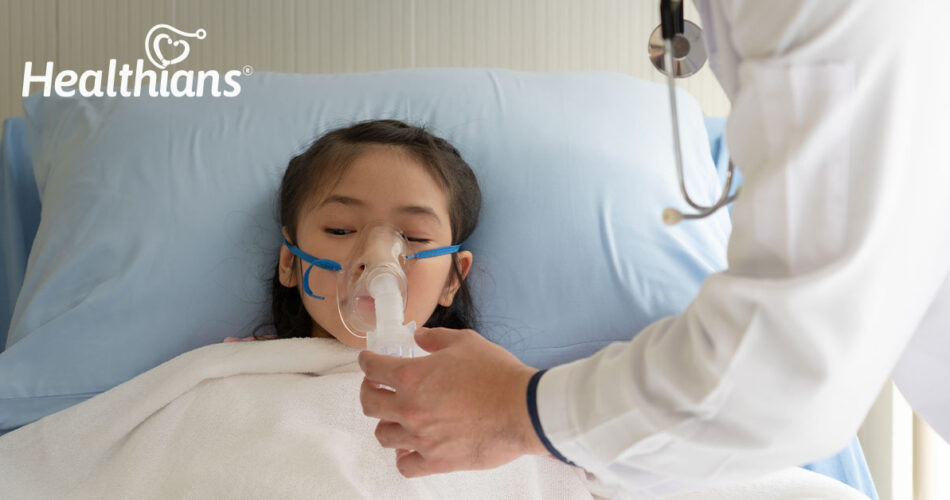Introduction
Did you know pediatric pneumonia is the reason for the deaths of more than 700,000 young children under the age of 5 worldwide each year, according to UNICEF?
Pneumonia is a type of lung infection. It could be minor or major. Pneumonia often affects kids under the age of five more frequently and elderlies.
Bacteria or viruses are more frequently to blame for pneumonia. Direct contact with a person who is already down with pneumonia can transmit the germs and viruses.
In this blog, we will highlight the causes, symptoms, diagnosis, treatment and prevention tips of pediatric pneumonia.
What is pediatric pneumonia?
Pediatric pneumonia is a subsequent sickness that appears as a result of the first viral or bacterial infection.
Symptoms of pneumonia often occur two to three days after a cold or sore throat onset.
The time, known as the incubation period, between exposure and the onset of pneumonia symptoms varies depending on the virus or bacterium responsible for the illness. For instance, signs of pneumonia from a respiratory syncytial virus (RSV) cold in a kid takes 4 to 6 days to manifest; symptoms of the flu virus arrive between 18 to 72 hours later.
Causes and symptoms of pediatric pneumonia
Causes of pediatric pneumonia
An acute respiratory infection of the lungs in kids is pediatric pneumonia. It can arise from bacteria, viruses, or fungi in the air; there is no one source for it. When a child is sick, fluid fills their lungs, making breathing challenging. Pneumonia is more likely to affect children with undeveloped immune systems (such as infants) or weaker immune systems, such as those caused by malnutrition or illnesses like HIV.
Symptoms of pediatric pneumonia
The most typical signs of pneumonia, which is an infection of the lungs, include coughing, breathing difficulties, and fever. Children with pneumonia typically breathe quickly, or when they inhale, their lower chest may constrict or retract (whereas in a healthy child, the chest expands during inhalation).
Diagnosis of pediatric pneumonia in children
Physical examination, unusual breathing patterns, and lungs-only listening can identify pneumonia in children. Blood tests and chest X-rays are also done to determine whether the youngster has pneumonia. It might sometimes be possible to tell if a kid has pneumonia by monitoring how many breaths they take in a minute.
Treatment of pediatric pneumonia
The treatment for pneumonia depends on the type of the disorder. Antibiotics are the mainstay of treatment for bacterial pneumonia in children; for viral pneumonia, supportive care can be combined with antiviral medicines. The child should also have enough fluids, get plenty of rest, and check for temperature often in addition to taking these drugs.
Placing a humidifier or air purifier might be beneficial. If the situation worsens, the kid could need advanced respiratory assistance, such as assisted breathing through a breathing machine, or more oxygen (High flow nasal cannula or mechanical ventilation)
Prevention of pediatric pneumonia
Although pneumonia cannot always be avoided, several lifestyle changes might lessen the likelihood of getting it and even limit the symptoms.
- Consuming a balanced and healthy diet
- Getting adequate sleep and controlling stress
- Practising excellent hand hygiene to lower the risk of infection
- Adhering to recommendations made by the doctor for maintaining health.
Final thoughts
As we discussed how and why pediatric pneumonia is the reason for a large number of deaths in kids, macro-level remedial actions by lowering the risk factors, fostering childhood immunity, and ensuring that people have access to high-quality healthcare services with the amenities they need can help in improving the condition.
Pneumonia may be avoided, considerably lowering infant mortality rates, with the help of a solid foundation and ecosystem of healthcare facilities, well-trained healthcare personnel and caregivers, addressing environmental risks, including implementing measures to limit air pollution.
Furthermore, you should also opt for preventive health checkups for your kids as they themselves cannot analyze their health condition. These health checkups give a complete report about your child’s health, allowing you to take necessary precautionary measures to improve their well-being and keep a host of ailments at bay.
FAQs (Frequently Asked Questions)
Q. What causes pneumonia in kids?
The main causes of pneumonia in kids are bacteria, viruses, or fungi in the air. Also, a weaker immune system can lead to the possibility of pneumonia.
Q. What habits cause pneumonia?
For adults, some lifestyle habits, like smoking cigarettes and drinking too much alcohol, can also raise your chances of getting pneumonia. Whereas in case of kids it can be weak immunity, infection and prolonged cold or cough.
Q. What are the 4 different types of pneumonia?
-Bacterial pneumonia
-Viral pneumonia
-Mycoplasma pneumonia
-Fungal pneumonia
Q. What is pneumonia classification?
Pneumonia is classified under four categories:
-Bacterial pneumonia
-Viral pneumonia
-Mycoplasma pneumonia
-Fungal pneumonia
Book The Mycoplasma Pneumoniae IgM AntibodyToday!
Written by: Anjali Sharma




